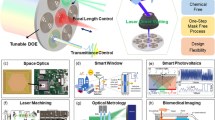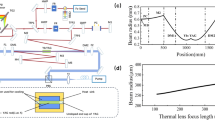Abstract
Direct femtosecond laser inscription has become an advanced and widespread maskless technology for waveguides writing inside optical materials. One of the advantages of the technology consists in combination of both high efficiency of integral optics and perfect thermal and spectral characteristics of bulk optical elements. In the paper we proposed, for what is believed to be the first time, femtosecond inscription of induced structures with modified refractive index (reduced down to −6 × 10−3) within significantly broad depth range (more than 550 μm) and waveguide with mode field diameter 200 μm, 30 mm length and numerical aperture 0.04. Proposed result broadens field of application of femtosecond writing technology into large mode diameter waveguides formation and hybrid integral-bulk laser schemes that create an opportunity to develop novel optical elements. Laser induced tracks with controlled refractive index were written with aspherical lens at all the depths within range between 550 and 1100 μm under the surface of the sample. Continuous writing process at significantly different depths was based on dynamic adjustment of femtosecond pulses energy to compensate negative effect of spherical aberration. In the investigation we examined dependences of writing energy range and geometry of induced refractive index tracks on writing depth. Experiments were carried out in Nd:phosphate glass in thermal cumulative regime (repetition rate of femtosecond pulses was 2 MHz) and compared with numerical simulation. It was shown, that dependence of working range on focusing depth is nonlinear, nonmonotonic and significantly differs for positive and negative shift from optimal correction depth of the lens.











Similar content being viewed by others
References
Barty, A., Nugent, K., Paganin, D., Roberts, A.: Quantitative optical phase microscopy. Opt. Lett. 23(11), 817–819 (1998)
Bukharin, M., Khudyakov, D., Vartapetov, S.: Heat accumulation regime of femtosecond laser writing in fused silica and nd: phosphate glass. Appl. Phys. A 119(1), 397–403 (2015)
Bukharin, M.A., Lyashedko, A., Skryabin, N.N., Khudyakov, D.V., Vartapetov, S.K.: Improved optical efficiency of bulk laser amplifiers with femtosecond written waveguides. In: SPIE Photonics Europe. International Society for Optics and Photonics, p. 98930G (2016)
Calmano, T., Petermann, K., Huber, G., et al.: Highly efficient yb: Yag channel waveguide laser written with a femtosecond-laser. Opt. Express 18(15), 16035–16041 (2010)
Dubov, M., Boscolo, S., Webb, D.J.: Microstructured waveguides in z-cut linbo 3 by high-repetition rate direct femtosecond laser inscription. Opt. Mater. Express 4(8), 1708–1716 (2014)
LZOS.: http://lzos.ru/content/view/16/29/. Accessed 26 Sept 2016 (2016)
McMillen, B., Li, M., Huang, S., Zhang, B., Chen, K.P.: Ultrafast laser fabrication of bragg waveguides in chalcogenide glass. Opt. Lett. 39(12), 3579–3582 (2014)
Mermillod-Blondin, A., Mauclair, C., Rosenfeld, A., Bonse, J., Hertel, I.V., Audouard, E., Stoian, R.: Size correction in ultrafast laser processing of fused silica by temporal pulse shaping. Appl. Phys. Lett. 93(2), 021921 (2008)
Nolte, S., Will, M., Burghoff, J., Tuennermann, A.: Femtosecond waveguide writing: a new avenue to three-dimensional integrated optics. Appl. Phys. A 77(1), 109–111 (2003)
Okhrimchuk, A., Shestakov, A., Khrushchev, I., Mitchell, J.: Depressed cladding, buried waveguide laser formed in a yag: Nd 3+ crystal by femtosecond laser writing. Opt. Lett. 30(17), 2248–2250 (2005)
Okhrimchuk, A.G., Mezentsev, V.K., Dvoyrin, V.V., Kurkov, A.S., Sholokhov, E.M., Turitsyn, S.K., Shestakov, A.V., Bennion, I.: Waveguide-saturable absorber fabricated by femtosecond pulses in yag: Cr 4+ crystal for q-switched operation of yb-fiber laser. Opt. Lett. 34(24), 3881–3883 (2009)
Osellame, R., Cerullo, G., Ramponi, R.: Femtosecond laser micromachining: photonic and microfluidic devices in transparent materials, vol. 123. Springer Science and Business Media, Berlin (2012)
Paganin, D., Nugent, K.A.: Noninterferometric phase imaging with partially coherent light. Phys. Rev. Lett. 80(12), 2586 (1998)
Pavel, N., Salamu, G., Jipa, F., Zamfirescu, M.: Diode-laser pumping into the emitting level for efficient lasing of depressed cladding waveguides realized in nd: Yvo 4 by the direct femtosecond-laser writing technique. Opt. Express 22(19), 23057–23065 (2014)
Rodenas, A., Kar, A.K.: High-contrast step-index waveguides in borate nonlinear laser crystals by 3d laser writing. Opt. Express 19(18), 17820–17833 (2011)
Salter, P., Baum, M., Alexeev, I., Schmidt, M., Booth, M.: Exploring the depth range for three-dimensional laser machining with aberration correction. Opt. Express 22(15), 17644–17656 (2014)
Streltsov, A.M., Borrelli, N.F.: Fabrication and analysis of a directional coupler written in glass by nanojoule femtosecond laser pulses. Opt. Lett. 26(1), 42–43 (2001)
Williams, R.J., Krämer, R.G., Nolte, S., Withford, M.J.: Femtosecond direct-writing of low-loss fiber bragg gratings using a continuous core-scanning technique. Opt. Lett. 38(11), 1918–1920 (2013)
Acknowledgements
This work was partially supported by Foundation for Assistance to Small Innovative Enterprises in Science and Technology, program U.M.N.I.K. (9398GU2/2015 No. 0020265 and 8611GU/2015 No. 0018824).
Author information
Authors and Affiliations
Corresponding author
Additional information
This article is part of the Topical Collection on Fundamentals of Laser Assisted Micro- and Nanotechnologies.
Guest edited by Eugene Avrutin, Vadim Veiko, Tigran Vartanyan and Andrey Belikov.
Rights and permissions
About this article
Cite this article
Bukharin, M.A., Skryabin, N.N., Khudyakov, D.V. et al. Dependence of femtosecond writing parameters in waveguide formation process within significantly broad depths range. Opt Quant Electron 49, 43 (2017). https://doi.org/10.1007/s11082-016-0879-1
Received:
Accepted:
Published:
DOI: https://doi.org/10.1007/s11082-016-0879-1




